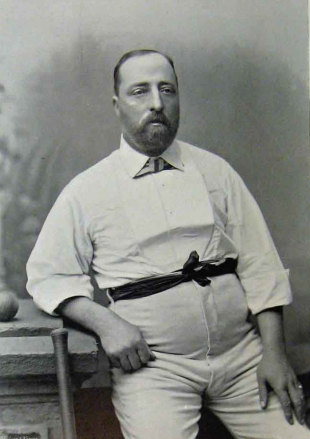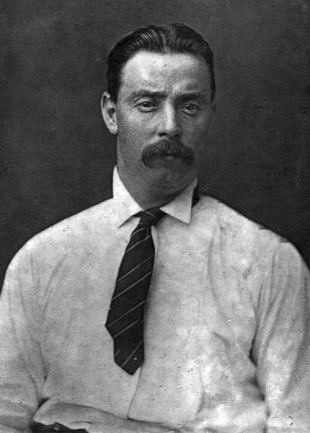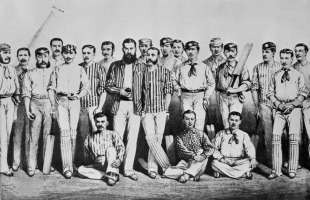Too good too soon
Simon Wilde
With the exception of eight wartime years, Wisden has been choosing its Cricketers of the Year ever since editor Charles Pardon introduced the award in 1889. That means the Almanack went through 25 editions - exactly one-sixth of its life - before the honour was first bestowed (to six Great Bowlers of the Year). Who, then, might rank as the most deserving cases for the quarter-century between Wisden's first edition in 1864 and Pardon's brainwave?

|
|||
|
Related Links
|
|||
It was a time of great change for cricket. Overarm bowling was legalised. County clubs replaced travelling teams as the game's power bases, and competed on an annual, if ad hoc, basis to identify champions. And international matches took off. The first Tests were played in Melbourne in 1876-77, triggering a regular exchange of tours between England and Australia. These contests became the ultimate gauge of ability, although the annual meetings between the Gentlemen and the Players at Lord's were almost as significant. Unless W. G. Grace was batting, bowlers were largely dominant. Pitches and outfields were often rough, and individual centuries rare for everyone except Grace: Richard Daft, an expert player of fast bowling, managed just seven hundreds in a career spanning more than 30 years.
Grace was still good enough to be named a Cricketer of the Year in 1896 at the age of 47. Other leading players from 1864 to 1888 who were later recognised by Wisden included Johnny Briggs, George Lohmann and Bobby Peel (all among the first picks in 1889); Billy Barnes, William Gunn and Arthur Shrewsbury (all 1890); and Walter Read (1893). Among Australians honoured were the great bowling partnership of J. J. Ferris and Charles "The Terror" Turner, both selected in 1889; Jack Blackham, recognised as the first great wicketkeeper, in 1891; and all-rounder George Giffen, in 1894. If Grace was the batsman by which every bowler was measured, then ALFRED SHAW (1842-1907) is a must-pick. There was no shortage of bowlers capable of operating for hours on end and cutting swathes through batting line-ups, but none was as consistently accurate as Shaw, who took more than 2,000 first-class wickets at 12 apiece in a career almost exactly spanning this period (he started in 1864 and stopped playing regularly after 1886). "He was a remarkably good 'head' bowler," said the Lancashire and England batsman Dick Barlow, "with a wonderful capacity for finding out a batsman's weak points; and could vary his bowling according to the state of the wicket as could no other bowler I ever saw." No one has taken 2,000 so cheaply, and the cost of his 186 wickets in 1880 - 8.54 each - is the lowest for any bowler claiming 100 in a season.
A short-built purveyor of medium-pace who spun the ball or made it break off the pitch, Shaw was accepted as the best bowler in England between 1870 and 1880. Grace said he did not find it difficult to keep him out on a good wicket, but had to be patient to score off him. Yet this was to damn with faint praise: Shaw took Grace's wicket 49 times, more than any bowler. Perhaps more pertinently, relations were not cordial after Shaw turned down Grace's terms for a tour of Australia in 1873-74, objecting to the second-class facilities on offer for the pros. Three years later, in Melbourne, he bowled Test cricket's first ball.
Shaw was as much entrepreneur as player, and acted as joint-promoter of four tours of Australia between 1881-82 and 1887-88, on the first of which he was captain. He also arranged the first British Lions rugby trip, to Australasia in 1888. Perhaps galvanised by the riches the supposedly amateur Grace had accrued, Shaw championed the professionals' cause, and led a strike at Nottinghamshire in 1881, demanding contracts that would guarantee a benefit season, which for many was an essential means of survival. The dispute did not stop him later captaining Nottinghamshire - in an era when amateur leadership was the norm - and taking them to four straight titles.
The fragmented organisation of early Tests meant few players commanded regular places in national sides, but one who did was GEORGE ULYETT (1851-98) of Yorkshire. He toured Australia five times, played in 25 of England's first 33 matches, and was good enough to be selected for either his aggressive batting or round-arm fast bowling; he was also a fine fielder. He once hit a ball over the roof of the old pavilion at Lord's, and split Charles Bannerman's finger during his 165 in the first-ever Test, forcing him to retire hurt. In that game, the Melbourne Argus said Ulyett was "pitching his cannon shots... not more than halfway down". One of the few Tests he missed was Australia's first in England, in 1880, when he and others refused to play in protest at a recent riot during a match in Sydney - an unexpected stand for a fun-loving man nicknamed "Happy Jack". In the period up to mid-1888, only three men scored more Test runs and only three took more wickets than Ulyett; overall, he gave 949 runs and 50 wickets to England's cause. Their first Test victory was aided by a pair of Ulyett fifties, and he bowled with genuine speed to rout Australia at Lord's in 1884, claiming seven for 36.

|
|||
Billy Bates, a fellow Yorkshire professional, made 656 runs and took 50 wickets in 15 Tests between 1881 and 1887, but all those games took place in Australia. Bates lost out on selection at home to amateurs who were rarely free to tour. One such was ALLAN GIBSON STEEL (1858-1914), known by his initials because he had six brothers, three of whom played, like he did, for Lancashire. He was restricted by his work as a barrister to one tour of Australia, in 1882-83 (averaging, in the Tests, 45 with bat and 17 with ball), but played in England's first nine home Tests, contributing strongly in Ulyett's absence to a win in 1880, and leading them to a 3-0 trouncing of Australia in 1886. Like Ulyett, Steel was a genuine all-rounder - an attacking middle-order batsman and a leg-spinner who could turn it both ways; unlike Shaw, he was more interested in wickets than maidens.
Steel was educated at Marlborough and Cambridge, and in his first full season of first-class cricket, in 1878, claimed 164 wickets at 9.43 apiece. For eight years, he rivalled Grace as the most glamorous cricketer in England. As the journalist and broadcaster Alan Gibson - who always included Steel in his all-time XIs on account of his Christian names - later wrote: "He used to wear a pill-box cap, a lavish moustache, a shirt buttoned to the neck, and a swaggering sash - at least that was how he liked to be photographed, the pattern of a Victorian gentleman/cricketer."
In 1884, Steel became the first to score Test centuries in both England and Australia, as well as the first to score a Test century at Lord's, where he has pride of place at the top of the honours board. His record with the ball was less remarkable in Tests (29 wickets at 20) than in first-class cricket (789 at under 15). But as late as 1926, the historian H. S. Altham stated: "Even today he must be written down as the best leg-break bowler in history."
After the last of Steel's 13 England appearances, in 1888, only one batsman had scored more Test runs at a better average - WILLIAM LLOYD MURDOCH (1854-1911). Armed with a small physique, quick footwork and stylish off-side strokes, Billy Murdoch was the outstanding Australian batsman of his era, a prolific accumulator on good pitches - his 211 on a flat'un at The Oval in 1884 was Test cricket's first double-century, and its highest score until 1903 - but technically good enough to cope in all conditions. He was the nation's champion, and it was his run-out that triggered that riot in Sydney.
"He always thought he was going to make a century," said C. B. Fry. "At least he did not think he was not going to, no matter whether he had a month of minute scores behind him."
Murdoch made 153 in the first Test ever played in England, in 1880, and scored more than 1,300 first-class runs on each of three subsequent visits. He led Australia on all of them, and was the first successfully to combine captaincy with consistent personal performances. A qualified solicitor, he gave up serious cricket after marrying into a mining family in the mid-1880s, having fallen out with the Australian authorities over the share of gate receipts awarded to players. But he was lured back to lead the 1890 Ashes trip. He became a close friend of Grace, and joined an English tour of South Africa in 1891-92, appearing in one match now deemed of Test status.
Murdoch played in 16 of Australia's first 17 Tests. The only one he missed was the very first, when his omission - as possible wicketkeeper - prompted Australia's best bowler to withdraw his services. FREDERICK ROBERT SPOFFORTH (1853-1926) was without question the greatest Test bowler of this period, and a key figure as Australia challenged England's notion of supremacy.

|
|||
Fred Spofforth began as an underarm bowler, but changed after watching the English cricketers on their 1863-64 tour. After his boycott of the inaugural Test, he took four wickets in the second. In 1878, he caused a sensation by claiming ten as the Australians dismissed MCC twice in a day at Lord's, for 33 and 19. He would henceforth be known as The Demon. Injury prevented him from playing in the 1880 Test, but in 1882 he bowled Australia to their famous win at The Oval after England - including Grace, Ulyett and Steel - had been left 85 to win. Incensed by Grace's devious run-out of Sammy Jones, who had left his crease to repair a divot, Spofforth urged his team on with the words: "Boys, this thing can be done." And he saw that it was, taking seven for 44 to clinch victory by seven runs.
A bank clerk who later became a tea merchant, Spofforth was essentially a medium-pacer from 1878, but he was a lean 6ft 3in and bowled with such skilful intensity that he struck dread into many batsmen. About two-thirds of his 853 first-class wickets were taken on five tours of England. He dismissed Grace 20 times, took the first Test hat-trick and, at the end of his last Test in January 1887, had picked up more wickets (94 at 18 each) than anyone.
Spofforth and Murdoch both eventually settled in England and, like the three Englishmen, played beyond the advent of the Cricketers of the Year. Ulyett and Steel appeared in their final county games in 1893. Spofforth, who turned out occasionally for Derbyshire and in festival matches, played his last first-class match in 1897, as did Shaw. Murdoch, who qualified for and captained Sussex, enjoyed a fine season in that year, when he scored 1,283 runs and led the county to sixth in what was now a properly constituted Championship of 14 teams. He might have been an imaginative inclusion among a Five, but Wisden - which had yet to pick an overseas county player - ignored his claims. No longer.
Simon Wilde is cricket correspondent of the Sunday Times and editor of Wisden Cricketers of the Year 1889-2013, to be published in October 2013

